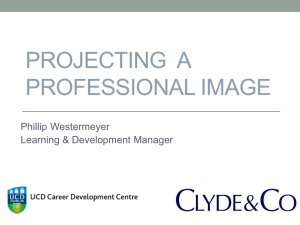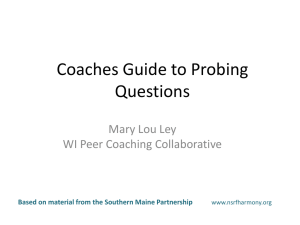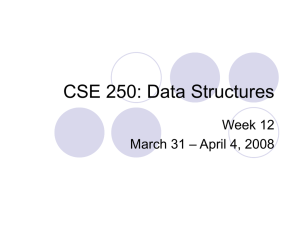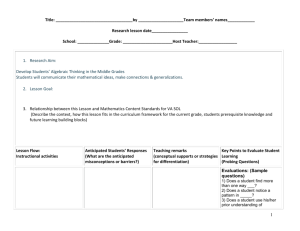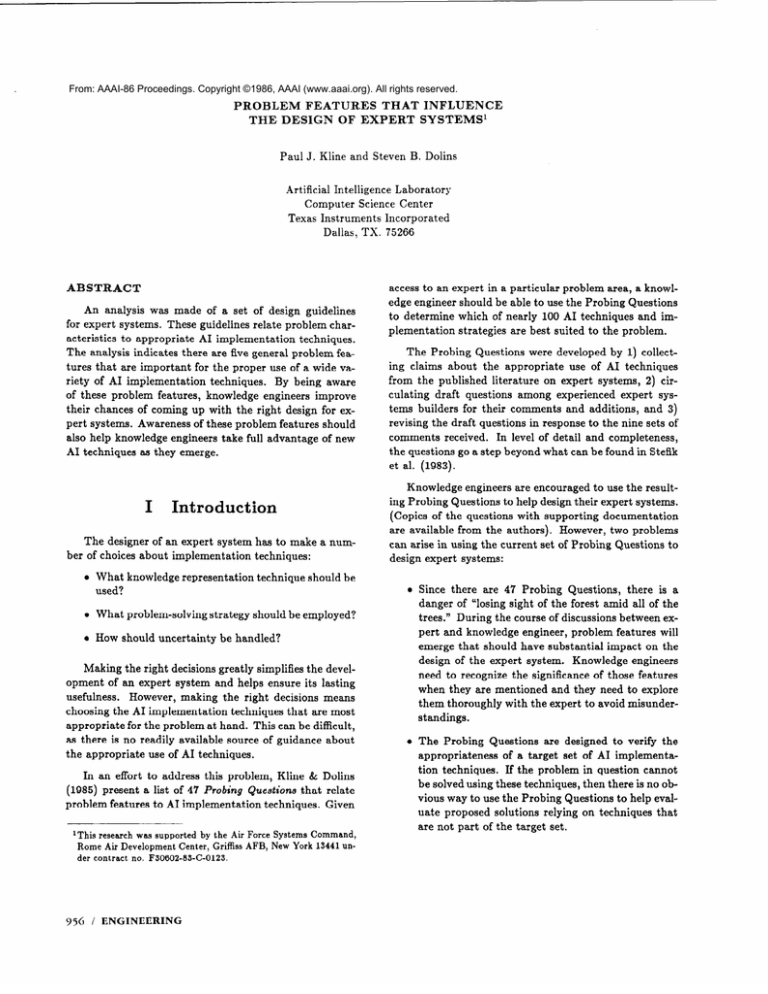
From: AAAI-86 Proceedings. Copyright ©1986, AAAI (www.aaai.org). All rights reserved.
PROBLEM
THE
FEATURES
DESIGN
OF
THAT
EXPERT
INFLUENCE
SYSTEMS’
Paul J. Kline and Steven B. Dolins
Artificial Intelligence Laboratory
Computer Science Center
Texas Instruments Incorporated
Dallas, TX. 75266
ABSTRACT
An analysis was made of a set of design guidelines
for expert systems. These guidelines relate problem characteristics to appropriate AI implementation techniques.
The analysis indicates there are five general problem features that are important for the proper use of a wide variety of AI implementation techniques.
By being aware
of these problem features, knowledge engineers improve
their chances of coming up with the right design for expert systems. Awareness of these problem features should
also help knowledge engineers take full advantage of new
AI techniques as they emerge.
I
Introduction
The designer of an expert system has to make a number of choices about implementation techniques:
What knowledge representation
used?
What problem-solving
How should uncertainty
strategy should be employed?
be handled?
In an effort to address this problem, Kline & Dolins
(1985) present a list of 47 Probing Questions that relate
problem features to AI implementation techniques. Given
lThis research was supported
by the Air Force Systems Command,
Rome Air Development
Center, Griffiss AFB, New York 13441 under contract no. F30602-83-C-0123.
I ENGINEERING
The Probing Questions were developed by 1) collecting claims about the appropriate use of AI techniques
from the published literature on expert systems, 2) circulating draft questions among experienced expert systems builders for their comments and additions, and 3)
revising the draft questions in response to the nine sets of
comments received. In level of detail and completeness,
the questions go a step beyond what can be found in Stefik
et al. (1983).
Knowledge engineers are encouraged to use the resulting Probing Questions to help design their expert systems.
(Copies of the questions with supporting documentation
are available from the authors). However, two problems
can arise in using the current set of Probing Questions to
design expert systems:
technique should be
Making the right decisions greatly simplifies the development of an expert system and helps ensure its lasting
usefulness.
However, making the right decisions means
choosing the AI implementation techniques that are most
appropriate for the problem at hand. This can be difficult,
as there is no readily available source of guidance about
the appropriate use of AI techniques.
956
access to an expert in a particular problem area, a knowledge engineer should be able to use the Probing Questions
to determine which of nearly 100 AI techniques and implementation strategies are best suited to the problem.
Since there are 47 Probing Questions, there is a
danger of “losing sight of the forest amid all of the
trees.” During the course of discussions between expert and knowledge engineer, problem features will
emerge that should have substantial impact on the
design of the expert system. Knowledge engineers
need to recognize the significance of those features
when they are mentioned and they need to explore
them thoroughly with the expert to avoid misunderstandings.
The Probing Questions are designed to verify the
appropriateness of a target set of AI implementation techniques. If the problem in question cannot
be solved using these techniques, then there is no obvious way to use the Probing Questions to help evaluate proposed solutions relying on techniques that
are not part of the target set.
Analysis of the Probing Questions indicates there are
five issues that are important for the proper use of a wide
variety of AI implementation techniques:
l
l
l
l
l
When does the information needed to solve problems become available? Information can be available at program-design time, data-input time, or
problem-solution time.
What kind of connection is there
and hypotheses ? There are many
and different program designs are
the maximum amount of leverage
between evidence
kinds of evidence,
required to obtain
from each kind.
What counts as a solution, and how many are there
likely to be? An expert system is entitled to stop
and declare the problem solved under a variety of
different circumstances.
How accommodating is the program’s environment?
That is, how much assistance in the form of information or guidance can the program rely on without
compromising its usefulness?
How can we help ensure that the program will expend its effort wisely. 7 It can be difficult to solve
problems within the constraints imposed by computational resources.
If knowledge engineers have these problem features in
mind during their discussions with experts they improve
their chances of getting the information they need to make
good implementation decisions. These problem features
should also be useful in evaluating solution proposals that
depend on the use of new AI techniques.
II
Analyzing
a Problem
Domain
An examination of the Probing Questions shows 23%
of those questions inquire about the expected arrival time
of information, 34% inquire about the connection between
evidence and hypotheses, 19% inquire about the definition
of solutions, 19% inquire about the degree of accommc+
dation provided the program’s environment, and 15% inquire about good use of resources. (The same question
can be counted in more than one category). While a substantial fraction, IS%, of the Probing Questions do not
raise any of the five issues, we were unable to discern
significant commonalities among the remaining questions.
These statistics suggest that if knowledge engineers have
thoroughly explored the five issues in their problem domains, then they should be able to answer most of the
Probing Questions. In the process, they will be able to
determine
mentation
the potential
techniques.
applicability
of many AI imple-
The following section discusses the Probing Question
that best illustrates the importance of the expected arrival
time of information. This is followed by brief summaries
of a few of the other Probing Questions that are part of
the 23% inquiring about that general issue. In all cases,
Probing Questions are labeled with the numbers they have
in Kline & Dolins (1985).
Subsequent sections use the
same format to illustrate the other four issues.
A.
When Does Information
Available?
Become
If the knowledge that makes it possible to solve
problems is available at program-design time, then it is
generally possible to build that knowledge directly into
the design of an expert system. In other cases, important
information only becomes available at data-input time or
after some progress has been made toward finding a solution. In these cases, a design must be found to take
advantage of the information as it emerges. Knowledge
engineers should appreciate that whenever they identify
a crucial item of information that makes it possible to
solve problems in a domain, they also need to establish
the expected arrival time of that information.
This issue comes up in the Probing Question shown in
Fig. 1, which determines whether constraint propagation
techniques will be required to find the values of variables.
If it is known at program-design
time that the values of
certain variables will always be provided as part of the input data, then forward chaining can be used to determine
the values of the other variables. On the other hand, if it
is necessary to wait until data-input time to discover which
variables have known values, then more general constraint
propagation techniques will have to be employed. The
choice between forward chaining and constraint propagation hinges on the question of exactly when information
will be available about the identities of the variables with
known values.
Other implementation
strategies for expert systems
are appropriate when certain kinds of information are
available at program-design time. For example (Probing
Question 2.3.1), if at design time it is possible to anticipate the major areas of uncertainty and unreliability the
program will face, then building redundancy into the design might help deal with the uncertainty (Buchanan &
Shortliffe 1984, p. 684f).
Besides program-design time and data-input time, there
are cases in which crucial information does not appear until a partial solution to a problem has been obtained. For
example (Probing Question 2.6.2), opportunistic search
strategies
wait for “islands” of certainty
KNOWLEDGE
to emerge and
ACQUISITION
/ 957
Is it necessary to find values for a number of variables that take on numeric or boolean values?
and
Are there constraints among the variables that make it possible to use the known values of some
of the variables to solve for other variables?
and
Does the identity of the variables whose values are known at the outset differ from problem
problem?
Yes, differ from problem to problem
+
No, same variables known at outset
--f Forward-Chaining
Constraint
to
Propagation
Rules
Figure 1: Probing Question 2.2.1
then use those islands to help interpret neighboring regions of greater uncertainty (Nii, Feigenbaum, Anton, &
Rockmore 1982). While the islands of certainty are crucial
to solving a problem, it is impossible to say where those
islands will be found until a certain amount of progress
has been made toward developing a solution.
B.
What Kind of Connection is There
Between Evidence and Hypotheses?
A wide variety of implementation strategies have been
employed in expert systems in order to extract the maximum amount of leverage from evidence. The Probing
Question in Fig. 2 is looking for several different kinds of
connections between evidence and hypotheses.
As this question suggests, a test for detecting that a
candidate is not a genuine solution can produce a positive
conclusion by eliminating all but one of a set of candidates,
i.e., confirmation by exclusion as in (Pople 1982, p. 13Of.).
The negative connection between evidence and hypotheses
leads to a different expert system design than is obtained
when there is total reliance on positive connections.
In other cases (Probing Question 2.4.9), a particular
piece of evidence restricts the solution to a range of possibilities without saying anything about which of those possibilities is actually the right on-for
example, Pople’s
“constrictors” (1977, p. 1033). This kind of connection
between evidence and hypotheses leads naturally to expert systems that organize hypotheses into a hierarchy
and proceed from general hypotheses (e.g., lung disease)
to more specific hypotheses (e.g., emphysema).
As a final example, it has been observed (Clancey
1984, pp. 55% Kahn 1984, p. 25f) that the nature of
the connection between evidence and hypotheses influences the choice of “shallow” versus “deep” reasoning in
expert systems (Probing Question 2.1.1). In some diag-
958
I ENGINEERING
nosis problems, the evidence is linked directly to bottomline conclusions.
Shallow reasoning employing heuristic
associations is appropriate for these problems. In other
diagnosis problems, evidence can be found that also confirms intermediate steps along a causal path connecting
ultimate causes to symptoms.
Deep reasoning employing a model of the operative causal relationships may be
appropriate for these sorts of problems.
c.
What Counts as a Solution, and How
Many are There Likely to Be?
Knowledge engineers and experts need to achieve a
clear understanding about the circumstances that will entitle the program to stop and declare the problem is solved.
Different stopping criteria will be appropriate in different
problem domains. For example, the output of the Rl expert system (McDermott 1982) is a functionally acceptable VAX system configuration.
There is no guarantee
the optimal configuration is found, but Rl is quite useful
nonetheless. In other problem domains a program would
need to keep working until an optimal solution is found.
A closely related question is the number of solutions
that are expected. For example, some medical expert systems can safely assume patients will only have one of the
diseases the program is capable of diagnosing (e.g., the
expert system discussed in Reggia, Nau, and Wang, 1984,
for determining the cause of the wasting of the muscles
of the lower legs). Other medical expert systems must be
prepared to deal with patients with multiple diseases. The
Probing Question in Fig. 3 makes recommendations for
the case where it is not reasonable to stop the diagnostic
process as soon pls one solution is found.
Discussions of the subtractive method recommended
in Probing Question 2.2.5 and examples of heuristics for
judging parsimony and detecting competitors can be found
Is it possible to construct a test that can be applied to each candidate
the test proves the candidate is a genuine solution?
(e.g., A combination
is clearly the right one if it opens the safe)
solution, so that passing
Or
Is it possible to construct
solution?
(e.g.,
Blood
a test, so that failing the test proves the candidate
tests can rule out paternity,
but not establish
is not a genuine
it.)
Of
Is there only a large “gray area” of better and worse candidates
Rule
candidates
an efficient
in, and there
to choose from?
is --f Generate-And-Test
generator
Rule candidates out
-+ Generate-And-
Gray area
+
Scoring
Test, Pruning,
Functions,
Group
or Confirmation
and Difierentiate,
By Exclusion
Opportunistic
Search,
etc.
Figure 2: Probing Question 2.7.3
in Pople (1977 p. 1032), Reggia, Nau, and Wang (1984),
and Pat& Szolovits & Schwartz (1981).
assume there is some true state of the world that gives rise
to the sensor data, then, in principle, there is only one legitimate solution. If the sensor data is sufficiently rich
to uniquely determine the underlying state of the world
(Probing Question 2.3.5), then an interpretation expert
system can be satisfied with finding one solution (Feigenbaum 1977, p. 1025).
There is a continuum of expert system problems that
ranges from multiple solutions at one extreme, passes
through a point where there is exactly one legitimate solution, and finally reaches a point at the other extreme
where there are no solutions to the problem as originally
stated. ISIS (Fox, 1983) provides an illustration of the
“no solutions” end of this continuum. ISIS attempts to
construct job-shop schedules that satisfy a number of constraints. It often turns out that there are implicit conflicts
between the constraints making it impossible to find any
schedule that satisfies them all. ISIS employs a constraint
relaxation scheme to define new problems that have a better chance of being successfully solved (Probing Question
2.9.2).
D.
How Accommodating
is the
Program’s Environment?
Expert systems provide assistance to their users,
but in order to do so, the programs themselves generally
need assistance in the form of information or guidance.
The amount of assistance that a program can rely on
without compromising its usefulness is another problem
feature that influences the design of expert systems. The
Probing Question in Fig. 4 is concerned with this issue.
Sensor interpretation problems will often be examples
of the “one solution” point on this continuum. If we can
This question suggests that one extreme of accommo-
Is this a diagnosis problem?
and
Would it be unwise to assume that there is only a single underlying fault because multiple faults
are either too common or too serious to run the risk of a mis-diagnosis?
Yes --+ Solve a sequence of problems that “Subtract
will need to use heuristic
between
competing
criteria
to determine
and complementary
Off” previously accounted for manifestations.
the most parsimonious
explanation
The system
and also to distinguish
hypotheses.
Figure 3: Probing Question 2.2.5
KNOWLEDGE
ACQUISITION
/ 959
What
is the nature of the environment
1. Cooperative
and knowledgeable
that provides inputs to the program?
users will provide inputs.
That is, certain users are likely to
2. Users are cooperative, but not always knowledgeable.
give unreliable answers to questions posed by the system.
3.
The environment is hostile and might therefore try to mislead the program with false inputs.
(e.g.,
4.
Enemy
ships
might
Neutral environment
way or another.
Both
cooperative
and knowledgeable
-+ Accept
try to hide
by emitting
misleading
the information
consistency
---f Expend
deception,
checks
much
that
when
effort
Reason
try to resolve
Neutral
at all.)
that is a source of data, but does not try to influence the program one
is input
Not always knowl- --j Tailor information gathering
users to indicate
how certain
edgeable
Hostile
or no signals
signals
and complete.
to the knowledge level of individual user, or allow the
they
users
are that
their
answers
are correct,
or apply
more
are less knowledgeable.
in Consistency
Explicitly
uncertainties,
as accurate
About
Checking,
set up demons’to
Uncertainty,
look for evidence
use Endorsement-Baaed
Approaches
of
to
etc.
--j Expend moderate effort on Consistency
Checking.
Figure 4: Probing Question 2.2.6
dation is the misleading information arising from deception in military settings and the other extreme of accommodation is the reliable information provided by cooperative and knowledgeable users. However, if guidance rather
than information is at issue (Probing Question 2.9.1)) then
an extreme case of accommodation is a division of labor
between man and machine where the user makes all the
critical decisions. The program might display the decision options and then trace the consequences of the user’s
decisions. With this kind of arrangement, the program is
not capable of solving the entire problem by itself and is
dependent on guidance from a very accommodating environment; i.e., a competent user to whom it can defer
decisions.
E.
How Can We Ensure that Effort is
Expended Wisely?
Many expert systems operate in domains where a combinatorial explosion of possibilities will defeat them if they
do not expend their efforts intelligently.
The Probing
Question in Fig. 5 illustrates a variety of approaches to
deciding what to do next so problems get solved within
the constraints imposed by resource limitations.
960
/ ENGINEERING
This question contrasts various global strategies for
directing the problem solving process. However, it is possible to make finer distinctions within some of the broad
categories that Probing Question 2.9.4 treats as equivalent. For example, the choice of a general purpose search
strategy also has implications for the program’s ability to
make good use of its resources. The data-driven reasoning
provided by forward-chaining search allows the program
to immediately recognize the implications of evidence that
strongly suggests a particular hypothesis (Probing Question 2.6.4). This rapid appreciation of the consequences
of new information is important in some problems.
In
other problems, the goal-driven reasoning provided by
backward-chaining
search leads to a better expenditure
of resources. This will be the case if it is important to
be sure that all inferences made could help achieve the
program’s current goals.
III
Analyzing
The Probing
Questions
an AI Technique
provide guidance
about the
appropriate use of nearly 100 AI techniques and implementation strategies.
However, there are other AI techniques-not included in that set, and new techniques are
Is there a fixed order of subtasks
that solves most problems
in this domain?
Or
Are the potential lines of reasoning few enough that the program can afford to investigate them
in the order that is most convenient for the reasoning strategy?
Or
experts routinely use their knowledge of the domain to make good choices of subproblems
work on next?
Do
to
OT
Will the program need to estimate the costs and benefits expected from invoking a line of
reasoning so as to best allocate computational resources among a wide range of possible lines of
reasoning?
Fixed
order of tasks
At the
of
convenience
the
+ Hard-wire
the flow of control,
+ General-purpose
search
e.g.,
strategies,
conventional
programming
i.e., forward-chaining,
or the Match
backward-chaining,
strategy.
etc.
reasoning
strategy
Domain
* Use
knowledge
next
determines
Control-Rules
that
embody
domain
knowledge
to reorder
the
Agenda,
set focus
tasks, or invoke rule sets.
task
Estimate
costs
benefits
and
+ Devise
an Intelligent
Figure
5: Probing
being developed fairly rapidly. Since descriptions of an AI
technique often do not say what problem features make
that technique appropriate, it would be helpful to identify
questions knowledge engineers could ask in order to make
a decision for themselves.
The five issues discussed in this paper provide some
candidate questions. Given a new AI technique, a knowledge engineer should ask: 1) what assumptions the new
technique makes about the arrival time of information, 2)
what kind of connection between evidence and hypotheses
that technique assumes, 3) what assumptions this technique makes about the nature of solutions, 4)how accommodating the program’s environment would have to be for
the technique to be useful, and 5) whether that technique
helps the program expend its effort wisely.
One way to estimate how useful these questions are
likely to be in characterizing the use of a new AI technique is to determine how often they help characterize
techniques in the current collection.
It was found that
these questions helped characterize the appropriate use of
approximately two thirds of those techniques.
As a concrete example, a case was discovered where
more precision was needed in asking about the expected
arrival time of information. A Probing Question that determines if means-ends
analysis is an appropriate
to order tasks on an Agenda according to their expected
is required about the costs and benefits associated with
Scheduler
benefits.
Meta-Knowledge
potential lines of reasoning.
search
Question
2.9.4
strategy
asks:
Is it relatively easy to guess that a certain crucial step will be required to solve
the problem?
Given the previous discussion of the need to distinguish program-design time from data-input time and
problem-solution time, it is now clear this question should
have been phrased
Is it relatively easy to guess at programdesign time that a certain crucial step will
be required to solve the problem?
attention
to the issues discussed in this paper,
it should be possible to avoid this kind of mistake in future
analyses of AI techniques.
By paying
IV
Conclusions
Analysis of the 47 Probing Questions in Kline & Dolins
(1985) indicates there are five issues that are important
for the proper use of a wide variety of AI implementation
KNOWLEDGE
ACQUISITION
/ 961
techniques.
By being aware of these issues, knowledge
engineers improve their chances of coming up with the
right design for expert systems. Awareness
of these issues
should also help knowledge engineers take advantage of
new AI techniques as they emerge.
ACKNOWLEDGEMENTS
We would like to thank Dr. Northrup Fowler III of
Rome Air Development Center for his valuable suggestions during the course of this research.
We are very
grateful to the expert systems builders who were kind
enough to comment on draft versions of the Probing @estions: Bruce Buchanan, Ruven Brooks, John Kunz, Penny
Nii, Michael Genesereth, Bruce Porter, Robert Drazovich,
Robert Neches, Tim Finin, Barbara Hayes-Roth, Casimir
Kulikowski, and Jim Kornell.
REFERENCES
Buchanan, B.G. & Shortliffe, E.H. (Eds.), Rule-Based Ezpert Systems: The MYCIN Experiments of the Stanford
Heuristic Programming Project, Reading, MA: AddisonWesley, 1984.
Extensions
to rules for explanation
Clancey,
W.J.
tutoring.
Artificial Intelligence,
and
1983, 20, pp. 215-251.
Fox, M.S. Constraint-directed search: A case study of jobPh.D. dissertation, Computer Science
shop scheduling.
Department, CMU, Pittsburgh, PA, 1983.
Feigenbaum, E.A.
The art of artificial intelligence:
I.
Themes and case studies of knowledge engineering. Proceedings of IJCAI-77, pp. 1014-1049.
Kahn, G. On when diagnostic systems want to do without
In ECAI-84:
Advances in Artificial
causal knowledge.
Intelligence. T. O’Shea (Ed.), Elsevier, 1984, pp. 21-30.
Kline, P.J. & Dolins, S.B. Choosing Architectures for Expert Systems. Final Technical Report RADC-TR-85-192,
October 1985, Rome Air Development Center, Griffiss
AFB, NY, 13441. (Available through the National Technical Information Service or the authors.)
McDermott, J.
puter Systems.
Rl: A Rule-Based Configurer of ComArtificial Intelligence, 1982, 19, pp. 3Q-
88.
Nii, H.P., Feigenbaum, E.A., Anton, J.J. & Rockmore,
A.J. Signal-to-symbol transformation:
HASP/SIAP case
study. The AI Magazine, Volume III, No. 2, Spring 1982.
Patil, R.S., Szolovits, P., Schwartz, W.B. Causal understanding of patient illness in medical diagnosis. Proceedings of IJCAI-81, pp. 893-899.
Pople, H.E.Jr.
The formation
in diagnostic problem solving:
962
/ ENGINEERING
of composite hypotheses
An exercise in synthetic
reasoning.
Proceedings of IJCAI-77,
pp. 1030-1037.
Pople, H.E.Jr. Heuristic methods for imposing structure
The structuring of medical
on ill-structured problems:
diagnostics.
In Artificial Intelligence in Medicine.
P.
Szolovits (Ed.), Boulder, CO: Westview Press, 1982.
Reggia, J.A., Nau, D.S., and Wang, P.Y. Diagnostic expert systems based on a set covering method.
In M.J.
Coombs, (Ed.) Developments in expert systems, New York:
Y
Academic Press, 1984.
Stefik, M., Aikins, J., Balzer, R., Benoit, J., Birnbaum,
L., Hayes-Roth, F. & Sacerdoti, E. The architecture of
expert systems.
In F. Hayes-Roth, D.A. Waterman, &
D.B. Lenat (Eds.)
Building Expert Systems, Reading,
MA: Addison-Wesley, 1983.

